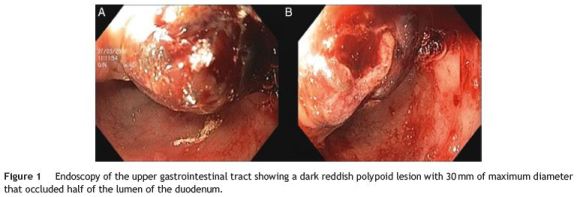Serviços Personalizados
Journal
Artigo
Indicadores
-
 Citado por SciELO
Citado por SciELO -
 Acessos
Acessos
Links relacionados
-
 Similares em
SciELO
Similares em
SciELO
Compartilhar
GE-Portuguese Journal of Gastroenterology
versão impressa ISSN 2341-4545
GE Port J Gastroenterol vol.22 no.4 Lisboa ago. 2015
https://doi.org/10.1016/j.jpge.2015.03.007
IMAGES IN GASTROENTEROLOGY AND HEPATOLOGY
Upper Gastrointestinal Hemorrhage as an Unexpected Feature of Hepatocellular Carcinoma
Um Achado Inesperado em Doente com Carcinoma Hepatocelular com Hemorragia Digestiva Alta
Rosa Coelhoa,∗, Branca Orfãoa, João Santos-Antunesa, Eduardo Rodrigues-Pintoa, Pedro Pereiraa, Helena Baldaiab, Guilherme Macedoa
a Gastroenterology Department, Centro Hospitalar de São João, Porto, Portugal
b Pathology Department, Centro Hospitalar de São João, Porto, Portugal
* Corresponding author.
Keywords: Carcinoma, Hepatocelular; Gastrointestinal Hemorrhage
Palavras-chave: Carcinoma Hepatocelular; Hemorragia Gastrointestinal
1. Case report
The authors describe a 63 year old male patient with a previous diagnosis of hereditary hemochromatosis (HH) performed an abdominal computed tomography (CT) that confirmed 2 liver masses compatible with hepatocellular carcinoma (HCC). He was proposed to chemoembolization treatment however he refused it. He presented in Emergency Department, nine months after, with melenic stool and epigastric pain, the laboratory work-up revealed hemoglobin 6.5 g/dL with MCV of 72.3 fl. Esophagogastroduodenoscopy was performed and revealed in the anterior and superior bulb wall, protruding into the duodenal lumen, a dark reddish polypoid lesion with 30 mm of maximum diameter that occluded half of the lumen (Fig. 1).

Biopsies were taken as it was not actively bleeding at the time of endoscopy. Histological analysis showed a fibrin clot with hepatic phenotype cells in the peripheral area. These cells showed cytological atypia and were disaggregated (Fig. 2A). Immunohistochemical studies revealed positive tumor cells staining for Heppar-1 (Fig. 2B), HSP-70 (Fig. 2C) and glutamine synthetize (Fig. 2D). Immunostaining showed negative results for CDX-2 and glipican-3, confirming the diagnosis of locally advanced HCC. Abdominopelvic CT was performed and showed multiple liver masses located in the left hepatic lobe, with the confluent lesions measuring 19.9 cm of maximum diameter, some of them occupied the right lobe (Fig. 3A). It was also possible to recognize evidence of local invasion of the first part of the duodenum (Fig. 3B). Supportive treatment was given and the patient died of hepatic coma three weeks after the episode of gastrointestinal bleeding.


2. Discussion
The authors describe a case of a duodenal invasion due to an HCC with upper digestive hemorrhage. In fact, the upper gastrointestinal bleeding is one of the most common complications in patients with HCC. Common etiologies include peptic ulcer disease, variceal bleeding due to portal hypertension from underlying cirrhosis, tumor invasion of portal vein causing thrombosis and portal hypertensive gastropathy.1-4 The direct invasion of tumor to gut is considered a rare cause among patients with a non-variceal source of upper digestive hemorrhage with an estimated incidence of 0.05-2%.5-7 The authors describe a 63 year-old male patient with a diagnosis of HCC who presented with melenic stool and epigastric pain. Esophagogastroduodenoscopy revealed in the anterior and superior bulb wall, a dark reddish polypoid lesion with 30 mm that occluded half of the lumen. Histological analysis confirmed the diagnosis of HCC with locally advanced disease.
Metastatic spread of HCC can be hematogenous, lymphatic or by direct invasion of the tumor into adjacent organs.4 In our case the abdominopelvic CT performed showed local invasion of the first part of the duodenum (Fig. 3B) making the direct tumor invasion of the gastrointestinal tract the most likely process. In conclusion, despite being a rare situation, gastrointestinal bleeding in advanced HCC should raise suspicions of duodenal involvement.
References
1. Lin CP, Cheng JS, Lai KH, Lo GH, Hsu PI, Chan HH, et al. Gastrointestinal metastasis in hepatocellular carcinoma: radiological and endoscopic studies of 11 cases. J Gastroenterol Hepatol. 2000;15:536-41. [ Links ]
2. Humbert P, Sarmiento J, Boix J, Planas R, Quintero E, Franquet T, et al. Hepatocellular carcinoma presenting with bleeding due to duodenal perforation by the tumor. Endoscopy. 1987;19:37-8. [ Links ]
3. Liang JD, Chen CH, Hsu SJ, Sheu JC, Yang PM, Lee HS, et al. Hepatocellular carcinoma with duodenal invasion and metastasis. J Gastroenterol Hepatol. 2012;27: 677-83. [ Links ]
4. Sayana H, Yousef O, Clarkston WK. Massive upper gastrointestinal hemorrhage due to invasive hepatocellular carcinoma and hepato-gastric fistula. World J Gastroenterol. 2013;19: 7472-5. [ Links ]
5. Yeo W, Sung JY, Ward SC, Chung SC, Lee WY, Li AK, et al. A prospective study of upper gastrointestinal hemorrhage in patients with hepatocellular carcinoma. Dis Sci. 1995;40:2516-21. [ Links ]
6. Maruyama A, Murabayashi K, Hayashi M, Nakano H, Isaji S, Uehara S, et al. Hepatocellular carcinoma complicated by gastrointestinal hemorrhage caused by direct tumor invasion of stomach. J Hepatobiliary Pancreat Surg. 1999;6:90-3. [ Links ]
7. Lynch P, Green L, Jordan PH, Graham DY. Hepatocellular carcinoma metastatic to the stomach presenting as bleeding multiple craterogenic ulcers. Am J Gastroenterol. 1989;84: 653-5. [ Links ]
* Corresponding author.
E-mail address: rosacoelhoabrantes@hotmail.com (R. Coelho).
Ethical disclosures
Protection of human and animal subjects. The authors declare that no experiments were performed on humans or animals for this study.
Confidentiality of data. The authors declare that no patient data appear in this article.
Right to privacy and informed consent. The authors declare that no patient data appear in this article.
Conflicts of interest
The authors have no conflicts of interest to declare.
Received 17 February 2015; accepted 24 March 2015














